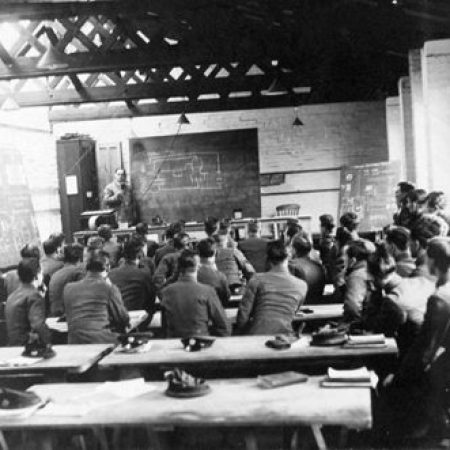In 2024, the Flowerdown military base, Winchester, at present home to the Army Training Regiment, is scheduled to close after 110 years of military occupation. Over the years, thousands of men and women have passed through its gates to serve the country.
Flowerdown has a distinguished story spanning the two wars. During WW1 it was used by British and Allied troops and between the wars, in collaboration with nearby RAF Worthy Down air station, it trained radio operators and technicians at the newly established RAF Electrical and Wireless School that later moved to Cranwell.
During WW2 it played a pivotal role in the Enigma story, its giant aerials receiving top-secret radio messages from German Axis forces that were passed within minutes to Bletchley Park for decoding.
In 1964, the large radio masts of Flowerdown were still standing clearly visible from roads around the site. A naval rating stood on guard duty at a sentry box whilst a White Ensign flew from a flagpole inside the camp entrance at the end of Chestnut Avenue. This entrance was known locally as “The Yankee Gate” from its use by US troops during WW1. Concrete street lighting columns from before WW2 can still be seen along Chestnut Avenue.
Local people had always been curious about the massive aerial towers on Flowerdown but at that time little was known to the general public. Former employees and service people were forbidden by the Official Secrets Act from discussing their role or the purpose of the base.
Codebreaking operations at Bletchley Park came to an end in 1946 but information about wartime operations remained classified as “top-secret” until the mid-1970s and even then, people involved would not talk about their work. In 1993, Bletchley Park opened its doors to the public and its role was revealed, along with that of Flowerdown.
There are few left who served there and the only book on the base is The Flowerdown Link, 1918-1978, by L.L.R. Burch, published in 1980. Over the years, more and more references to the site have appeared on the web and in popular literature, and its story has become clearer. These have allowed me to research its history in more detail, leading to a 214-page collection of notes which I recently donated to the Hampshire Record Office.
My approach to the Flowerdown story has simply been to collect and organizeall the information I came across in an unplanned manner and where the fancy took me, to record its distinguished and honourable story and the memories of some of those who were stationed there. The result is the story of Flowerdown military base between 1912 and the present day. My hope is that at some time a permanent memorial will be established on the site.
The research notes on Flowerdown are deposited with the HRO, ref. 11A20/1.
Contributed by Brian Middleton, brian@venta.plus.com

